|
|||||
FlyingRC.net is a
Veteran-Owned site.

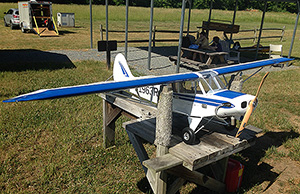 |
Taking the Hangar 9 1/4-scale PA-18 Super Cub from box to flight line involved a bit over 20 hours of work, but it was worth it, for a while... Click image to enlarge |
Hangar 9 1/4-Scale PA-18 Super Cub
FlyingRC.net finally gets a Cub!
Text, photos and video by Tom Hintz
Posted – 6-11-2015
While I am not into scale RC flying personally I am a fan of the famed Piper Cubs, particularly the Super Cub. Though it will never be a 3D machine this version does have a surprisingly “unhighwinger-ish” flight envelope. While this is a totally different style of flying than my Aeroworks 50cc Edge 540 or RedwingRC 50cc YAK 55 the Hangar 9 1/4-scale PA-18 Super Cub presents different capabilities and challenges that are rather un-Cub like. This is not a “bank and yank” rocket but rather a rudder-heavy finesse plane that often requires cross control inputs to get the most out of it.
The Basics
The Hangar 9 PA-18 Super Cub has a 106 in wing span with 1630 sq. in of wing area. Overall length is 68.0 in and flying weight should be 16.5–18.5 lb. (My Hangar 9 1/4-scale PA-18 Super Cub came in at 17.5 lbs.) Recommended power options for the Hangar 9 PA-18 Super Cub include 1.20–1.60 2-stroke glow; 1.20–1.80 4-stroke glow; 20–26cc 2-stroke gas; 30cc 4-stroke gas and Power 110 or equivalent electric motor. I opted to use my DLE40-twin for a little extra “kick in the pants” performance.
The wing has scale-sized ailerons and functional flaps. Both of these control surfaces are made more realistic appearing with molded exteriors featuring the ribbed contours of the full-scale version. The flaps even have the down only hinging with hidden pushrods and servos. The ailerons have a “dummy” pushrods up top to simulate the real pull-pull linkage of the full-scale Super Cubs. The functional struts are designed to fold flat for easier transportation and faster setup.
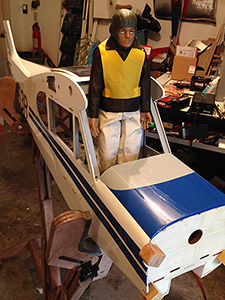 |
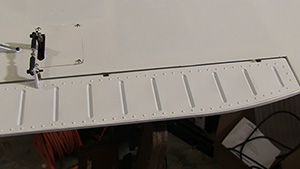 |
The kit comes with this scale pilot figure (left) and seats that I left out. The ailerons (right) and flaps look very scale thanks to the contoured caps installed at the factory. Click images to enlarge |
|
One of the “must-have’s” in a Cub model is the functional, bungee-type suspension on the main gear equipped with realistic Super Cub wheels. (I cheated here also, see below) The Hangar 9 PA-18 Super Cub is float-ready in that it has mounting points for the optional float kit built into the airframe.
The fuselage features realistic tail feathers complete with flying wires. The cabin door is operational and held shut with strong magnets. The upper portion of the door is also held open by a magnet hidden in the wing under the covering. The fiberglass cowl has molded-in panel lines and other detail along with a nice paint job that includes striping that matches up well to the striping down the fuselage.
Other scale features included with the Hangar 9 PA-18 Super Cub are a full-body pilot figure, a pair of seats that are held in with magnets and a dash panel with instruments. You also get a painted, aluminum spinner. If you have small enough radio equipment some of that can be installed below the floor in bays with screw-on lids, the “screws” in this case being front and rear simulated control sticks. I’m not that into scale and have real-world radio gear so the seats and pilot stay in the shop.
Assembly
Hangar 9 estimates assembly time at up to 20 hours and that is not unreasonable given some experience with building a modern ARF. The parts are logically bagged and the included printed instruction manual very complete. Just finding a printed manual these days is cause for a mid-level celebration.
The tail section has a bunch of tubes fixed into the frame that carry the pull-pull wires and a pair of elevator pushrods from the rear of the cockpit because that is where those servos are mounted. The pushrods are 4-40 rod with threaded ends. I have to admit being skeptical of these pushrods and worried about flex during control inputs but in use they seem fine.
In line with the sort-of scale appearance they included “dummy” linkage on top for the wing for the mechanical pull-pull ailerons on the full scale Super Cub. One of the upper control horns was snapped off in the box and I abandoned the other one shortly after the maiden flight. I cut the existing upper horn off and ironed covering over the slots for the fake pushrods. I just am not that big of a scale fan. I am sure Hangar 9 would have made it right if I asked.
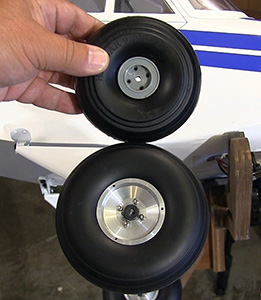 |
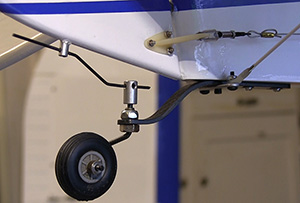 |
The upper wheels (left) came with the kit but I had the lowe4r wheels so they won out. You get a double coil spring tail wheel with the kit but I hate them and love the tiller style (right) that I got from RedwingRC that steers way better. Click images to enlarge |
|
I had seen on forums that some do not like the metal clevises that come with the Hangar 9 PA-18 Super Cub. They are the good ones and are 4-40 so I used them for most of my build and the only problem with them was me forgetting to put thread locker on one of the flap linkages which dutifully fell apart during day two at the field.
Not So Hot
There are subtle differences between the left and right ailerons and they can actually be installed on either side but one way produces a miss alignment with the flaps. The manual does speak to this and shows the miss alignment that results if they are installed on the wrong side. Why not simply mark them as “left” and “right”? I suppose then we would have to establish, pilots left and right or facing the plane left and right. Whatever, pay attention to this!
Plastic ends on tail feather flying “wires” seem like a great place for a vibration-induced failure early in the flying life of the Hangar 9 PA-18 Super Cub. The “wires” are actually solid rod threaded on the ends. I wonder about the weight of those rods under the vibrations of a gas engine. I have a Sullivan cable flying wire set on hand just in case.
I have long hated the dual coil spring-type tail wheel assemblies and the Hangar 9 PA-18 Super Cub came with one. I left that in its plastic bag and replaced it with 30cc “tiller” style tail wheel assembly from RedwingRC. Like the one that came with the plane, the RedwingRC model features a carbon fiber arm but uses a straight spring wire to steer the tail wheel. If the wheel bangs something the spring wire soaks up that shock rather than the servo yet the plane steers reliably, something I could never achieve when trying to adjust the length/strength of dual springs. Also, the springs seem to break in short order for me and then I just cut the other one and let the rudder to the turning. See the Sources section below for a link to the RedwingRC tail wheel page.
Rubber bands for main wheel suspension may have seemed like a good idea years ago but modern modelers are more apt to use rubber O-rings or small-diameter bungee cord like that now gracing my Hangar 9 1/4-scale PA-18 Super Cub. You can buy this bungee cord from Balsa USA of all places but it works and is adjustable! I know you are tempted to make the suspension soft to soak up less than perfect landings but this is a Cub with a huge wing and flaps! It lands at a walk so just practice landings for a while! Yes, I broke a prop (20”) bouncing my Hangar 9 1/4-scale PA-18 Super Cub on soft suspension but do as I say, not as I do, sometimes.
Conclusions
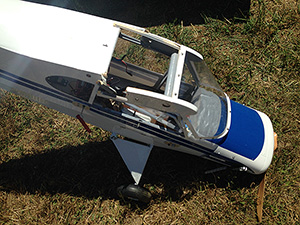 |
||
I got brave in too much wind with a soft suspension and cartwheeled the Hangar 9 1/4-scale PA-18 Super Cub (left) on the first day. a friend fixed it up like new for the real maiden day the next week. Click image to enlarge |
||
The Hangar 9 1/4-scale PA-18 Super Cub ARF is a good kit with out of the ordinary scale features for those who enjoy that part of modeling. The airframe is straight, tough and larger than I expected. While I did not use the supplied main wheels or the dual spring tail wheel assembly all of the parts and hardware included are more than sufficient. There are many Hangar 9 1/4-scale PA-18 Super Cub chugging around the skies with all of the standard pieces in place.
Hangar 9 deserves kudos for producing one of the increasingly scarce printed instruction manuals that actually has needed information in it. The photos are actually photos and not some kind of copy machine disaster we find in too many of in kits these days, if there instructions at all.
If you like the Cub style of plane the Hangar 9 1/4-scale PA-18 Super Cub should be of interest. With a street price of $619.99 (sale price 5-21-2015) it is a bargain in the giant scale world as well. The availability of accessories and parts also set this plane apart from the self-proclaimed big plane experts selling lesser kits for more.
Sources
Hangar 9 product page - Click Here
RedwingRC Tail Wheel Assembly web page – Click Here
Balsa USA Bungee Cord – Click Here
Have a comment on this review? –Email Me!
All Flyingrc.net written, photographic and drawn materials are property of and copyright by Tom Hintz and Flyingrc.net 2013-2020 Materials cannot be used in any way without the prior written permission of the owner.
Privacy Statement


